MIDWEEK UPDATE 8 JULY 2015
By the Pilot's Post team
THIS WEEK IN MIDWEEK UPDATE
Plan your weekend
Forthcoming events
Notice Board
This week in aviation history
Worldwide incidents and accidents
Aviation News
Advertising rate card

11 July: Krugersdorp Spotlanding Competition. Contact: acr@absamail.co.za
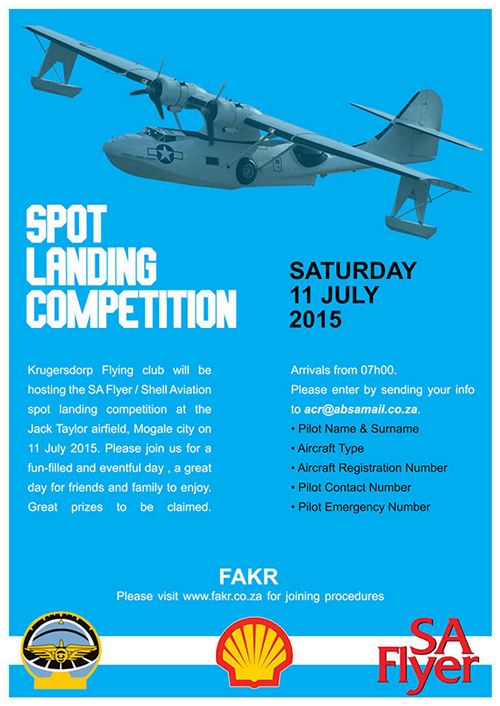

16 to 19 July: Sports Aerobatics Club Nationals - Klerksdorp. Contact Annie Boon chunge@mweb.co.za
17 to 19 July: Nylstroom Taildraggers fly-in - Nylstroom Flying Club. Contact Richard Nicholson e-mail rgn@pcwireless.co.za Cell: 082 490 6227
19 July-3 August: EAA's annual AirVenture to be held in Oshkosh USA. Camping on the airfield contact Neil Bowden e-mail: neil1@telkomsa.net
Hotels in Appleton contact Calvin Fabig e-mail: calvin@designer.co.za
1 Aug: The East Rand Flying Club invites aviators to a free fly-in breakfast. Breakfast will be served from 08:00 till 10:30 in the club hangar to the South of runway 14/32. Parking will be along the taxiway in front of the hangars to the South of 14/32. FASI frequency is 122.4. Call crossing N12 to North & N17 to the South.
Join overhead @ 6800' for light aircraft & 6300' for microlights.
Runway 03/21 is tar. Runway 14/32 is grass. Runway 04/22 grass is now a taxiway.
All circuits to the NORTH for 32. Takeoff from 14 NOT PERMITTED. All circuits to the WEST for 03/21.
Contact Paul Sabatier 082 413 4614
1 August: SAAF Museum flying training and open days. Contact Capt. Kobus Kapp 012 351 2342 or E-mail: webmaster@saafmuseum.org
1 - 2 August: Namibian airshow. Contact Reinhard Gartner e-mail: reinhard@fivestar.co.za
7-10 August: EAA National Convention & AGM. Margate Airport. RSVP at: rsvp@eaa.org.co.za

7-9 August: SAPFA Fun Rally Brits. Contact Frank Eckard e-mail: frank.eckard@mweb.co.za
14 - 15 August: Bethlehem airshow. Contact Stephan Fourie e-mail: fouriesj1491@gmail.com Cell: 072 344 9678
20 - 29 August: Sports Aerobatics Club Unlimited World Championships - France Contact Annie Boon chunge@mweb.co.za
23 August: Grand Rand airshow (Sunday) Contact Stuart Coetzee e-mail: manager@randairport.co.za Tel: 011 827 8884
29 August: Bethlehem Aero Club fun navigation rally. Contact Izak Venter e-mail: izak@motsu.co.za or Francois Marais e-mail: info@stanfra.co.za
12 - 13 August: Sports Aerobatics Club Gauteng regionals and Judges Trophy - Vereeniging Contact Annie Boon chunge@mweb.co.za
4-6 September: Petit Vintage and Classic Fly-in. Contact Ivan van der Schaar 0823759180
5 September: SAAF Museum flying training and open days. Contact Capt. Kobus Kapp 012 351 2342 or E-mail: webmaster@saafmuseum.org
18-20 September: Pyramid Air Park Aviators Weekend Barberton. Contact Peter Lea peter@irricon.co.za or 0825534908
17-20 September: Botswana Air Race at Matsieng, It is going to be the best ever race with sponsored fuel, tents and lots more. Contact chris@airteam.co.za
3 October: SAAF Museum flying training and open days. Contact Capt. Kobus Kapp 012 351 2342 or E-mail: webmaster@saafmuseum.org
3 October: SAPFA Fun Rally Grand Central. Contact Jonty Esser e-mail: jontye@x7online.co.za Cell: 076 302 0451
10 October: Spring 2015 TMG Fly in at Bundu Inn Flying Estate. Contact Marietjie van Niekerk on 0827656670 or marietjievn@gmail.com
24 - 25 October: Sports Aerobatic Club KZN regionals - Ladysmith. Contact Annie Boon chunge@mweb.co.za
31 October: Bethlehem Aero Club fly-in and hangar dance. Contact Izak Venter e-mail: izak@motsu.co.za or Francois Marais e-mail: info@stanfra.co.za

BE A SAFETY FIRST AVIATOR
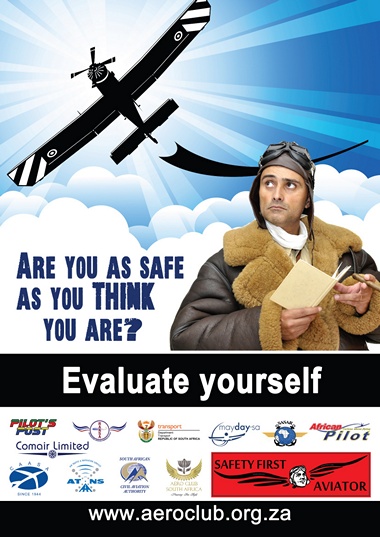

July 8 1988 - 11-year old Chris Marshall flies a Mooney M20 from San Diego to Paris.
July 8 1908 - Thérèse Peltier becomes the first woman to fly in an aeroplane. She is a passenger on a flight made by Léon Delagrange at Turin.
July 9 1910 - Walter Brookins attains an altitude of 6,175 feet in a Wright biplane, becoming the first to fly a mile high and wins a prize of $5,000 for his feat.
July 10 2013 - A Northrop Grumman X-47B unmanned combat air vehicle demonstrator lands aboard USS George H. W. Bush (CVN-77) in the Atlantic Ocean off Virginia. It is both the first time that an unmanned aerial vehicle lands on an aircraft carrier autonomously and the first extended autonomous flight by a military unmanned aerial vehicle of any kind
July 10 1935 - Bell Aircraft Corporation is founded in Buffalo, New York.
July 12 1957 - President Eisenhower becomes the first U. S. president to fly in a helicopter when he is flown from the White House to an unnamed military post in a USAF Bell UH-13 J.
July 12 1849 (July 12 and July 25) - Balloons (Montgolfières) are used for bombardment for the first time, with Austrians bombing Venice.
July 14 1934 - Howard Hughes lands in New York after a record-breaking 14,874-mile trip round the Northern Hemisphere with a Lockheed Electra 14 in 3 days 19 hours.
July 14 1919 - To protest against the fact that pilots have to parade on foot at the World War I victory parade on the Champs-Elysées in Paris, French pilot Charles Godefroy flies his Nieuport fighter under the arches of the Arc de Triomphe.
July 14 1905 - Orville Wright has a serious crash with Wright Flyer III, upon which the Wright Brothers radically alter the aircraft. The front rudder is mainly the culprit for the Flyer's insistent pitching.

USA, Denver: A United Airlines flight that departed Denver International Airport bound for Boston had to return to DIA because of a passenger who was seated in the economy section and refused requests to stop smoking.
Argentina: A pair of Argentinian pilots has been fired after videos of a Playboy model in the cockpit were leaked. In addition to firing the pilots and banning the model, Austral announced forthcoming criminal proceedings against the three "for putting the flight's safety at risk."
USA; Colorado: (Reuters) - A Flight for Life AS350 B3e medical transport helicopter crashed during a take-off in Colorado. The pilot was killed, and a flight paramedic and flight nurse was seriously injured.
USA, JFK International: Delta Airlines Flight 546 bound for JFK International in New York from the Dominican Republic made emergency landed at Norfolk International Airport after indicators alerted pilots to a possible engine problem July 5, 2015. None of the 131 passengers and 6 crew members on board sustained injuries.

IOMAX INTRODUCES ALL NEW ARCHANGEL PRECISION STRIKE / RECONNAISSANCE AIRCRAFT AT THE 2015 PARIS AIR SHOW
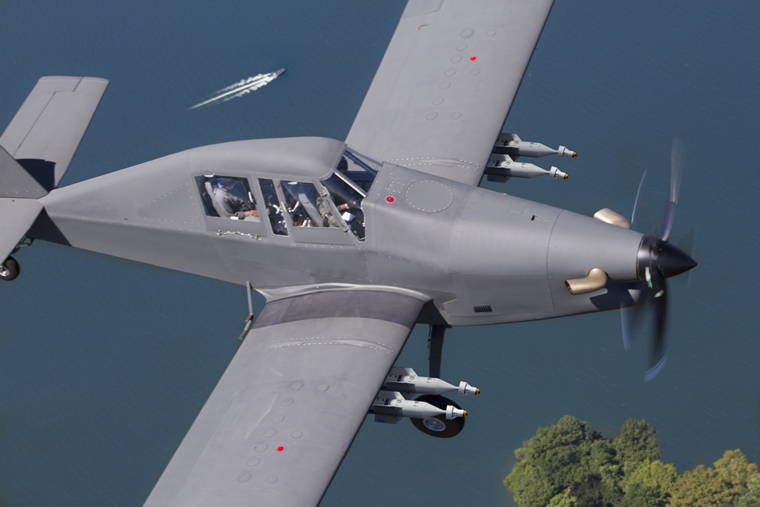
IOMAX, based in Mooresville, North Carolina USA is introduced a new armed reconnaissance variant of the Thrush S2R-T660 turboprop at the 2015 Paris Air Show. The design and development of the aircraft, trademarked the Archangel, began in November of 2012 and builds on IOMAX's history of delivering the only currently fielded, heavy precision strike / Intelligence, Surveillance and Reconnaissance (ISR) equipped Border Patrol Airplane (BPA) in the world.
The employment of the first generation BPA developed by IOMAX, based on the Air Tractor (AT-802), proved to be a force multiplier for a Middle East customer. The idea to convert the airplane's two greatest strengths, its ability to carry an extremely large payload with its simplicity of design, fulfilled a critical void which had existed in the aviation battle space for decades. Although the strategy of designing and employing an extremely sophisticated precision strike / ISR capability on board an aircraft designed for agricultural spray operations seemed to contradict current worldwide trends towards unmanned air vehicles, the concept has proven extremely effective in various combat environments over the past five years.
During the process of fielding the first generation BPA, IOMAX encountered several limiting factors, as would be expected with any first generation product. "We wanted to design and offer our clients an affordable platform for the border security mission which would holistically address the performance and safety deficiencies of the first generation BPA. In order to achieve this in the future, we realized that we would have to partner with the aircraft manufacturer throughout the design, integration and manufacturing processes," explained Ron Howard, IOMAX President and CEO.
To this end, IOMAX selected Thrush Aircraft's S2R-T660 aircraft as the basis for the next generation BPA. IOMAX also established an exclusive relationship with Thrush Aircraft and jointly invested in the design and development of the Archangel, the next generation, purpose-built BPA.
The Archangel improvements include an elevated rear cockpit ergonomically designed as a functional crew position by repositioning the cockpit forward on the airframe. This yielded pilot visibility and ergonomics more suited for long endurance flight operations. Additionally, IOMAX improved the man machine interface, added self-sealing fuel tanks, ballistic protection, an enhanced composite propeller to reduce audible signature and provide better high altitude performance, an oxygen supply system and increased the cruise speed. The result is a mission aircraft that allows operations in medium threat environments, with a service ceiling of 25,000 feet, speeds in excess of 210 KTAS (clean, 10,000 ft), over 9 hours loiter at altitudes that make it inaudible to ground threats, and highly integrated military mission avionics.
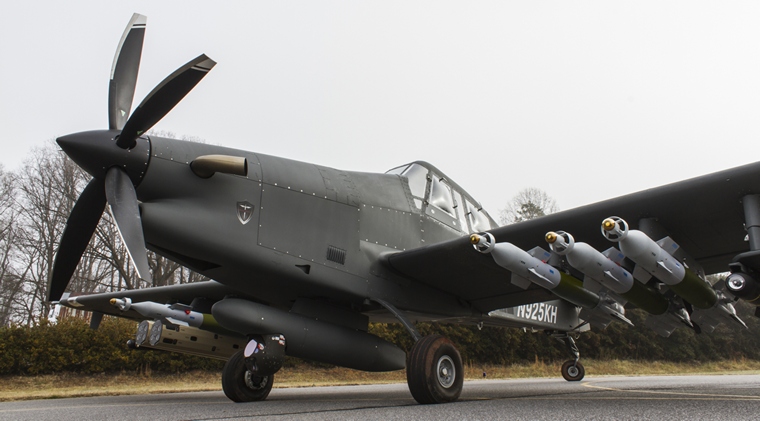
The Archangel is uniquely equipped with a high performance EO/IR reconnaissance and targeting capability combining a suite of precision strike weapons that can execute precision strike missions with low collateral damage against both moving and fixed targets. The EO/IR system allows for wide area search and also magnification for identification. The Archangel carries munitions similar to existing fixed wing attack aircraft and helicopters, including 2.75" (70 mm) Laser Guided Missiles, Hellfire AGM-114 Missiles, and GBU-58 and GBU-12 Paveway II Laser Guided Bombs.
With all six wing store stations carrying weapons, the Archangel provides the ability to engage a broad spectrum of both soft and hard targets. From patrol boats to ground vehicles, the Archangel provides the crew the means to locate, identify, track, destroy and conduct battle damage assessment. Load out examples include 48 precision laser guided 2.75" missiles or 12 Hellfire missiles or 6 Paveway II guided MK81 or MK82 bombs. No current military platforms are known to accommodate this variety of weapons needed for the precision strike and CAS roles.
Howard believes the Archangel fills a broad void in border defense worldwide. "Border security has never been more important. Archangel is a quantum leap forward in terms of performance and safety as it employs the lessons learned from the earlier BPA aircraft. We are proud of what we have accomplished with the Archangel - it is truly unlike any aircraft in the world."
CONSUMER JETPACKS WILL BE FLYING BY 2016, MARTIN AIRCRAFT SAYS, BUT FIRST YOU NEED $150K
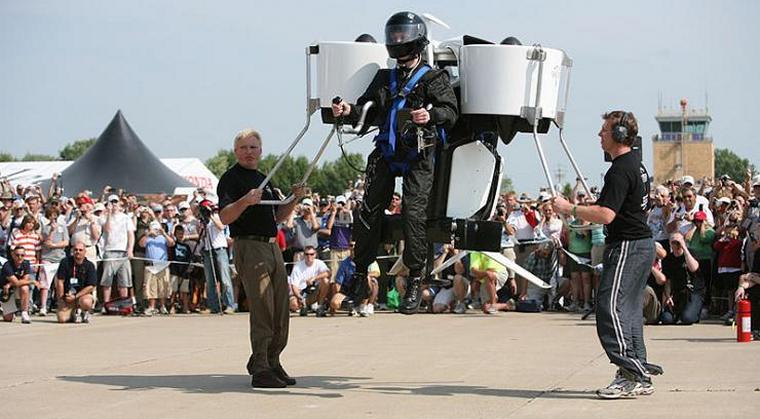
The first flight of the Martin Jetback, shown here in 2008, reminded observers of science fiction fantasies popularized in the 1950s and 1960s.
The jetpacks have finally arrived. Decades after science fiction writers first popularized the idea of strapping a rocket to your back and piloting yourself through the air, a New Zealand aircraft company has announced it will actually start selling commercial jetpacks for a price of $150,000. But consumers will need to wait until 2016.
Built by the Martin Aircraft Company, the jetpack (known as the Martin Jetpack) would be the first aircraft of its kind to go on sale to the public. Rather than being powered by rockets, though, the jetpack lifts off and navigates with help from large fans, which are easier to control. It's capable of carrying a 260 pound person 1,000 meters into the air before they deploy a parachute, company sources told Reuters.
Even with such a high cost, Martin suggested jetpacks will be more than a toy for millionaires. They say the aircraft can safely land on wire-laden rooftops and navigate tight areas, two advantages over a helicopter.
"I think the first responders will see that as a massive improvement to their capability," Peter Coker, chief executive of Martin, told Reuters. "Naturally for the ambulance service getting to a point of importance of rescuing people in the shortest possible time [is crucial]."
The aircraft was first put on display at the Paris Air Show last week. The first jetpacks, which the U.S. Federal Aviation Administration classifies as an experimental aircraft, are scheduled for delivery during the second half of 2016.
CIRRUS AIRCRAFT SELECTED BY ST. LOUIS UNIVERSITY

Cirrus Aircraft announced today a partnership with the Saint Louis University's Parks College of Engineering, Aviation, and Technology to add SR20 trainer aircraft to its flight training fleet. The delivery of these new airplanes marks the latest selection of SR-series Cirrus aircraft by a premier pilot training program to provide a technologically advanced, easy-to-fly modern training platform that will prepare students to fly tomorrow's commercial airliners, military and general aviation aircraft.
"This partnership with Saint Louis University demonstrates real forward-thinking at Parks College regarding the future of their flight training," remarked Todd Simmons, Cirrus Aircraft's Executive Vice President and Chief Customer Officer. "Selecting SR20s as the foundation of its teaching and learning programs places Parks among a rapidly growing list of flight schools and academies that recognize the importance of training in the safest and most advanced aircraft available today."
The Cirrus SR20 series selected by Parks College is a welcome addition to the college's flight school. Designed to be the most technologically advanced training aircraft on the market, the SR20 boasts an impressive list of features and capabilities. The integrated Cirrus Perspective™ by Garmin® flight deck includes two large 10" flight displays, a Flight Management System (FMS) keypad controller, plus integrated engine indication and crew alerting/warning systems - all features found on advanced airliners today. In addition, the Cirrus Perspective flight deck includes an all-digital automatic flight control system and flight director, as well as ADS-B NextGen capabilities, giving students early experience with important aircraft systems they will be using for the rest of their careers. The SR20 also includes a state-of-the-art electronic stability system, akin to the envelope protection systems that are becoming standard features on all new airliners and military aircraft. To top it all off, the airplane's durable all-composite structure and signature Cirrus Airframe Parachute System® (CAPS®) make the aircraft one of the safest and most versatile training airplanes available today.
"Teaming with a collegiate flight program that has such a rich aviation history and recognized record of success in the global aviation community is an honor for us," commented David Moser, Cirrus Aircraft's Vice President of Fleet and Special Mission Aircraft. "It's a privilege for the entire Cirrus team to help continue the Parks College tradition of excellence in flight training."
Saint Louis University's Parks College of Engineering, Aviation, and Technology is world renowned for its pioneering history. The school is the oldest and first federally licensed flight school in the United States. Originally named Parks Air College in 1927 by its founder Oliver Parks, the school offered training for those seeking commercial pilot certification. In the late 1930's it helped prepare military pilots for combat missions, and in 1938 was one of three schools to form the Civilian Pilot Training Program. It ultimately trained more than 37,000 cadets by the end of WWII before Mr. Parks gifted his college to Saint Louis University in 1946. Today, the school offers degree programs in aviation and flight science, aviation management, global aviation, and more than 100 other disciplines.
Stephen Belt, Department Chair of Aviation Science at Saint Louis University's Parks College of Engineering, Aviation, and Technology, is enthusiastic about the new additions to the fleet: "Our goal is to provide a world-class flight training experience and set students up for success in their future careers. Integrating Cirrus SR20s into our training fleet is another sign of our commitment to offer the best training environment to our pilots."
Adding Saint Louis University to the Cirrus Aircraft fleet portfolio continues to broaden the company's global training presence. With airplanes already in use by the US Air Force Academy, the Royal Saudi Air Force, the French Air Force and Navy, the Civil Aviation Flight University of China, and other prestigious flight training institutions, Cirrus Aircraft continues to be the training aircraft of choice for premier flight training programs.

PIPER TO EXHIBIT M600 MOCKUP AT EAA AIR VENTURE OSHKOSH
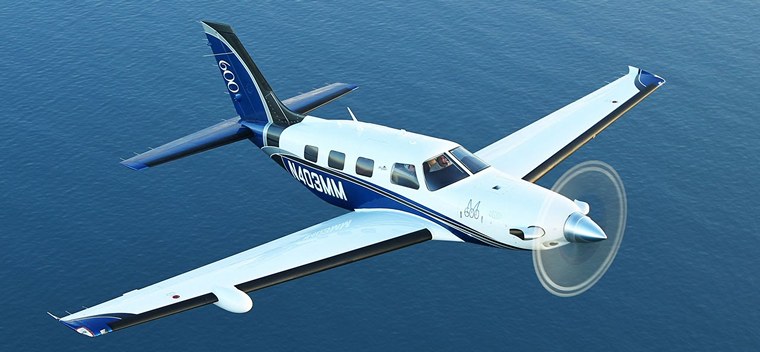
Piper Aircraft will display the M600 in its mockup form during EAA AirVenture Oshkosh 2015, scheduled July 20 - 26.
"AirVenture Oshkosh remains the greatest general aviation venue in the world," said Piper President and CEO Simon Caldecott. "Piper plans to take full advantage of this gathering of aviators to exhibit our latest product, the M600, as well as offer a glimpse of the future generation of Piper Aircraft."
Piper is also planning a press conference on the initial day of the Experimental Aircraft Association's AirVenture to update the aviation media on recent activities at Piper Aircraft, including the recent rollout of the new M-Class line, the M350, the Meridian M500, and the M600. The press conference will also include discussion of the company's alternative fuel initiative with the recently certified diesel Archer DX.
On display at the Piper static exhibit in the Main Aircraft Display area 140-145, 156-161 will be the M600 mockup, the single-engine turboprop Meridian M500, the pressurized single-engine piston-powered M350, and the unpressurized single-engine Matrix, which comprise the Piper M-Class in its entirety.
Also on display will be the Twin-Class and Trainer-Class Seminole and Seneca V. Additionally, Piper will be exhibiting the Trainer-Class Piper Archer, which remains favored with flight schools around the world.
About Piper M-Class Aircraft
Piper M-Class aircraft offer Piper performance and safety, built upon a proven airframe that has been an industry standard for years. Three refined, cabin class derivatives comprise the full line: the M600, Meridian M500, and the M350; the Matrix is also part of the M-Class family. Each product fits its own niche and price point, and each aircraft provides a seamless step-up to the next level. Created to maximize the business and private travel experience, the M-Class line offers market-leading safety, as well as performance, efficiency, and value.
About the Piper M600
The Piper M600 is significant product advancement, featuring a new, clean sheet design wing and a sophisticated Garmin G3000 touchscreen-controlled glass flight deck. The M600 seats six and is powered by a Pratt & Whitney PT6A-42A 600shp engine. The aircraft has a maximum cruise speed of 260 KTAS/ 482 km/h, a max range of 1,300 nm / 2408 km, and a max payload of 1,200 lbs. / 544 kg. The G3000 avionics suite is the next generation of Garmin architecture, offering the most comprehensive, intuitive, and technologically advanced package on today's market. The M600 will be listed at a competitive price of $2.82 million.
BELL 525 RELENTLESS MAKES SUCCESSFUL FIRST FLIGHT
World's first commercial fly-by-wire helicopter achieves highly anticipated milestone
Bell Helicopter, a Textron Inc. (NYSE: TXT) company announced the successful first flight of the Bell 525 Relentless. The maiden flight of the super-medium helicopter took place at the company's aircraft assembly center in Amarillo, Texas.
"The Bell 525 was announced at Heli-Expo in 2012, and we are proud to have achieved this milestone. We have diligently executed our schedule to design, develop, build and test the aircraft, and look forward to the next phase of flight testing as we work towards certification," said Matt Hasik, executive vice president of commercial programs at Bell Helicopter. "The marketplace has been awaiting the transformational capabilities of the Bell 525 and we continue to see growing customer demand from around the globe for this aircraft."
The Bell 525 was designed with input from our Customer Advisory Panel as an aircraft to meet future requirements for operational safety, payload & range, cabin comfort and configuration and reliability. One of the unique characteristics of the Bell 525 is the ability to perform CAT-A takeoffs and landings, to and from a helipad at maximum gross weight. Even in the event that one of the two engines fails, the Bell 525 provides sufficient power to maintain occupant safety while lifting off with a single operational engine. With over 60 helicopters reserved under letters of intent, the Bell 525 is designed to provide operators and end users unmatched situational awareness and the ability to perform a wide variety of missions under challenging weather conditions.

"The Bell 525 performed extremely well today," said Troy Caudill, senior flight test pilot at Bell Helicopter. "I am excited to be a part of the development of this advanced aircraft and help define the future of vertical lift."
"The first flight test started with taxi testing and maneuvers and then went into an initial hover, performing various hover maneuvers and then tested low speed handling qualities with winds gusting to 20 knots," added Jeff Greenwood, senior flight test pilot at Bell Helicopter.
The Bell 525 is the world's first fly-by-wire commercial helicopter designed to operate safely and reliably in austere environments with decreased pilot workload. The aircraft features the first fully-integrated touch screen avionics suite designed for helicopters, the Garmin G5000H. Best-in-class payload, cabin, cargo volumes, and passenger comfort complement the technological advancements on the aircraft.

AIRVENTURE TO COMMEMORATE 70TH ANNIVERSARY OF WORLD WAR II'S END
Photo credit: Jim Koepnick. Some of history's most iconic airplanes will be highlighted at EAA AirVenture Oshkosh 2015 during EAA's 70th anniversary commemoration of the Allied victories in World War II. The 63rd annual EAA convention and fly-in takes place July 20-26 at Wittman Regional Airport in Oshkosh.
"This is an extremely important milestone anniversary of arguably the most significant event of the 20th century - the end of World War II both in Europe and in the Pacific," said Rick Larsen, EAA's vice president of communities and member programs, who leads the AirVenture event organizing team. "Our goal is to highlight the significance of the anniversary and do our best to portray a historically accurate representation of the air war."
Victory in Europe Day (V-E Day) on May 8, 1945, marked Germany's unconditional surrender to the Allies, which ended the long and costly war that had ravaged Europe and cost millions of lives. On Friday, July 24, the afternoon air show will feature a tribute to air power in Europe, launched by a special Battle of Britain 75th anniversary performance. EAA is currently pursuing a number of representative aircraft examples from the European Theater of Operations including B-17 bombers, a variety of fighter and transport aircraft, and a Lancaster bomber.
Victory over Japan Day (V-J Day) - on September 2, 1945 in the U.S. and August 14, 1945 in the U.K. - marked the surrender of Japan, which ended nearly five years of war in the Far East. This year's Wednesday and Saturday air shows will commemorate the men, women, and aircraft in the conflict, beginning with the return of Commemorative Air Force's "Tora! Tora! Tora!" air show recalling the December 7, 1941, attack on Pearl Harbor.
EAA is working on securing the appearance of the actual Interstate Cadet high-wing aircraft that is generally recognized as the first aircraft in Pearl Harbor to be attacked by Japanese planes. The airplane was flown that infamous morning by instructor pilot and future WASP Cornelia Fort, who escaped a strafing attack after landing.
Other aircraft used in key Pacific battles will also be represented during the Wednesday and Saturday performances, including those flown in Doolittle's Raid, the Battle of Midway, and subsequent island hopping campaigns.
The V-J Day commemorative air shows will culminate with participation by the world's only flying B-29, the CAF's FIFI. In addition, the Wichita, Kansas-based restoration team for the B-29 Doc hopes to bring that airplane to Oshkosh this year.
Other activities commemorating the 70th anniversary of the end of World War II will be announced as they are confirmed.

Valdez STOL Aircraft Returning to AirVenture
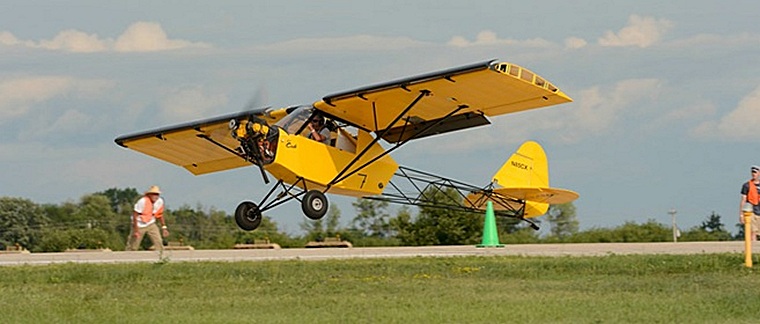
Frank Knapp takes off in his Lil' Cub during the Valdez STOL competition at EAA AirVenture Oshkosh 2014. Photo credit: DeKevin Thornton
The specially modified short takeoff/landing (STOL) aircraft that were a hit at EAA AirVenture Oshkosh 2014 will return to Wittman Regional Airport for the 63rd annual convention and fly-in. These aircraft compete at the annual Valdez, Alaska, fly-in and air show each May, and more than a dozen of them will demonstrate their unique capabilities at Oshkosh this year.
The STOL aircraft, including homebuilts and specially modified production airplanes, will participate. They're based on aircraft that provide supplies to the rugged and far-flung outposts throughout Alaska whose demanding terrain requires takeoffs and landings on rough runways often less than 500 feet long.
The Valdez STOL activities will include flying during the afternoon air show and on selected evenings at EAA AirVenture's grass airstrip for ultralights on the south end of the grounds. These flying activities are made possible with support from CubCrafters, one of the nation's leading backcountry aircraft manufacturers.
"We knew that last year's Valdez flying competitions and demonstrations would be popular, but we had little idea how much fun it would be for both participants and those who watched them," said Rick Larsen, EAA's vice president of communities and member programs. "The pilots drew cheers during the afternoon air show demonstrations and thousands of aviation enthusiasts crowded around the ultralight runway for the informal post-air show evening festivities with the airplanes. This is true grassroots flying, perfect for Oshkosh."
While the airplanes and pilots involved are commonly from Alaska, aviators and aircraft from throughout North America are expected to participate once again this year. Last year, it was common to see these aircraft take off and land in less than 50 feet. There will be flight competitions during the afternoon air shows on July 20-21, competition finals prior to the July 22 night air show, and fun flying at the ultralight airstrip on July 23 (mid-day) and July 24 (evening).


|
                      |























